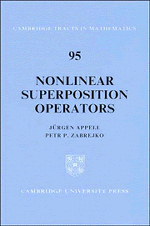Book contents
- Frontmatter
- Contents
- Preface
- Chapter 1 The superposition operator in the space S
- Chapter 2 The superposition operator in ideal spaces
- Chapter 3 The superposition operator in Lebesgue spaces
- Chapter 4 The superposition operator in Orlicz spaces
- Chapter 5 The superposition operator in symmetric spaces
- Chapter 6 The superposition operator in the spaces C and BV
- Chapter 7 The superposition operator in Hölder spaces
- Chapter 8 The superposition operator in spaces of smooth functions
- Chapter 9 The superposition operator in Sobolev spaces
- Bibliography
- List of Symbols
- Subject Index
Chapter 5 - The superposition operator in symmetric spaces
Published online by Cambridge University Press: 05 February 2012
- Frontmatter
- Contents
- Preface
- Chapter 1 The superposition operator in the space S
- Chapter 2 The superposition operator in ideal spaces
- Chapter 3 The superposition operator in Lebesgue spaces
- Chapter 4 The superposition operator in Orlicz spaces
- Chapter 5 The superposition operator in symmetric spaces
- Chapter 6 The superposition operator in the spaces C and BV
- Chapter 7 The superposition operator in Hölder spaces
- Chapter 8 The superposition operator in spaces of smooth functions
- Chapter 9 The superposition operator in Sobolev spaces
- Bibliography
- List of Symbols
- Subject Index
Summary
Symmetric spaces are ideal spaces whose norm may be defined by means of the decreasing rearrangement of measurable functions. Thus, all general results discussed in Chapter 2 carry over to such spaces, but some results may be sharpened. For instance, the main statements on the boundedness, Lipschitz continuity, or differentiability of the superposition operator between symmetric spaces can be formulated more explicitly in terms of the so-called fundamental function.
The most important examples of symmetric spaces, apart from those discussed in Chapters 3 and 4, are the Lorentz space ∧φ and the Marcinkiewicz space Mφ. These spaces play a fundamental role, for example, in interpolation theory of linear operators.
After recalling the notions and properties of symmetric spaces, in general, and Lorentz or Marcinkiewicz spaces, in particular, we formulate some elementary results on the superposition operator between such spaces. Unfortunately, the theory is here much less advanced than in, say, Lebesgue and Orlicz spaces. The results presented here are mainly combinations of special properties of symmetric spaces and general results obtained in Chapter 2.
Symmetric spaces
Let Ω be an arbitrary set, M some σ-algebra of subsets of Ω, and µ a σ-finite and count ably additive measure on M; as before, by λ we denote some equivalent normalized measure on M.
- Type
- Chapter
- Information
- Nonlinear Superposition Operators , pp. 141 - 162Publisher: Cambridge University PressPrint publication year: 1990
- 2
- Cited by

